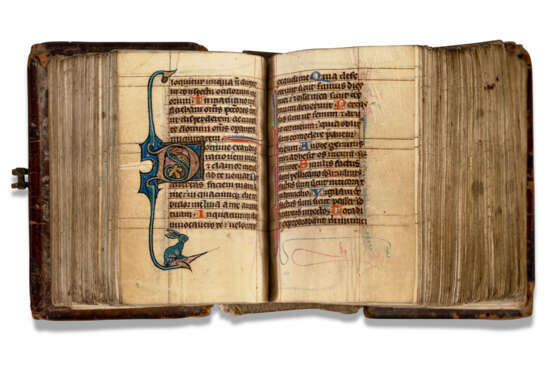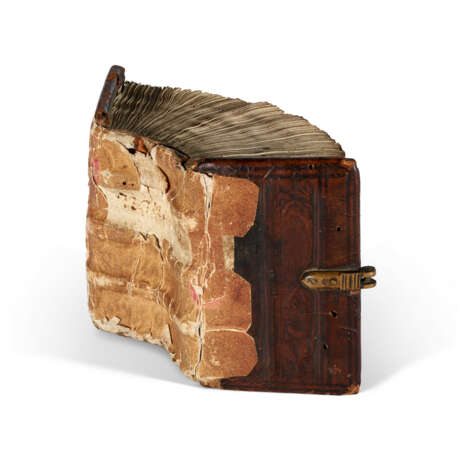ID 813782
Lot 1 | BREVIARY, for Premonstratensian use, in Latin
Estimate value
$ 25 000 – 35 000
Illuminated manuscript on vellum [Hainaut, 1270s-1280s]
BREVIARY, for Premonstratensian use, in Latin, illuminated manuscript on vellum [Hainaut, 1270s-1280s].
A charming 13th-century pocket Breviary providing a wealth of information regarding the liturgy of Vicogne, in the medieval province of Hainaut.
70 x 50mm. 696 leaves (of 706), collation: 112(of 14, lacking i, ii), 2-516 , 614(of 16, lacking viii, ix), 716, 815(of 16, lacking ix) 9-2116, 2210, 23-2916, 3015(of 16, lacking x), 31-3716, 3815(of 16, lacking i), 39-4016, 4115(of 16, lacking i), 42-4416, 458(of 10, lacking ix, x), traces of catchwords in extreme lower right corner on last versos, and of alphabetical signatures in lower right corners of rectos in first half of each gathering, 16 lines written in two sizes of gothic liturgical bookhand in dark brown or red ink between two vertical and seventeen horizontal lines ruled in brown ink, the verticals and the 1st and 2nd, 8th and 9th, and 15th and 16th horizontals extending into the margins, ruled space: 42 x 27mm. 20 decorated initials in blue, mauve, ochre and orange, most with foliate infilling and marginal extensions, several inhabited by dragons, one with a small blue rabbit perched on the tail of the letter, numerous two-line Lombard initials alternately red and blue flourished in the opposite color, most pages with red and blue pen-flourishing extending the height of the page in the left margin, one line versal initials alternately red and blue, text capitals slashed red (some oxidization of colors, some cropping, insignificant losses to two blank margins, some staining to c.30 leaves with occasional ink corrosion, minor fraying to blank margins of last c.15 leaves). 16th-century blind-stamped calf over wooden boards, remains of one clasp (pastedowns removed, a few small wormholes, spine reinforced with 18th-century pink paper); modern velvet-lined drop-back box.
Provenance:
(1) Vicogne (near Valenciennes), Premonstratensian abbey: made for use there as indicated by the calendar and the prominence given to initials for the feasts of the Purification and St Blaise. Located in the medieval province of Hainaut, Vicogne was founded as a hermitage, but in c.1130 it was settled by canons from the Premonstratensian abbey of St Martin at Laon and became a daughter house of that monastery. In 1139 it achieved the status of abbey in its own right, and survived until it was suppressed in 1790. In the 18th century its library was praised by the Maurists. The first church of Vicogne was extensively reconstructed beginning in the 1260s: this reorganization may have inspired the creation of the present Breviary, which on stylistic grounds is to be dated to the 1270s or 1280s.
(2) Christie's London, 28 June 1995, lot 13, to Quaritch.
(3) Helmut N. Friedlaender (1913-2008), lawyer and bibliophile: his sale, The Helmut N. Friedlaender Library, Part 1, Christie's New York, 23 April 2001, lot 1.
Contents: Calendar (lacking Jan. 1-15), with various medieval and later additions and some erasures, ff.1-12; prayers f.12v; psalter ff.13-263; canticles ff.263v-283; litany and prayers ff.283-290; hymns ff.290v-339v; Temporale ff.340-516; Sanctorale ff.516-648v; Common of Saints (lacking end) ff.648v-696v.
The abbey was dedicated to Saints Blaise and Sebastian, with an additional dedication to the Virgin Mary. The calendar of the present manuscript gives the feasts of Blaise (Feb. 3) and Sebastian (Jan. 20) in red, and the feast of Blaise has an octave. In addition, the feasts of Blaise and the Purification of the Virgin are marked in the calendar with a small cross where the grade of the feast is indicated, and the offices for these days are distinguished by their initials. Two abbots of Vicogne are commemorated among the original entries in the calendar: Walterus de Quesnoy, abbot 1212-1230 (Mar. 12), and his successor, Aegidius de Lovanio, abbot 1230-1235 (Mar. 9). Soon after the completion of the Breviary, a single hand made a number of additions which illustrate the local piety and spiritual relationships of Vicogne in the second half of the 13th century. These commemorations include Gerardus de Chèvres, abbot of Vicogne 1235-1258 (May 10), and Nicolaus de Fontanis, bishop of Cambrai 1248-ca. 1273 (Mar. 2), as well as a collective commemoration of the brothers, sisters, benefactors and servants of the monastery (Mar. 10). Dom[i]nus Norbertus (June 6) is Norbert of Prémontré, founder of the order, who was not canonized until 1582. The addition on May 9 of the translation of St Nicholas was perhaps due to the influence of St Martin at Laon, where this feast also figured prominently in the liturgy. The commemorations of other, neighboring Premonstratensian houses probably indicate that confraternities of prayer existed with these communities: they include Bonne Esperance (Mar. 1), Vermand (Mar. 22), Valsery (July 7), and Laon (Sept. 2). Still later additions to the calendar and to the margins of the Sanctorale reflect the further development of the liturgy at Vicogne.
| Address of auction |
CHRISTIE'S 20 Rockefeller Plaza 10020 New York USA | ||||||||||||||
|---|---|---|---|---|---|---|---|---|---|---|---|---|---|---|---|
| Preview |
| ||||||||||||||
| Phone | +1 212 636 2000 | ||||||||||||||
| Fax | +1 212 636 4930 | ||||||||||||||
| Conditions of purchase | Conditions of purchase | ||||||||||||||
| Shipping |
Postal service Courier service pickup by yourself | ||||||||||||||
| Payment methods |
Wire Transfer | ||||||||||||||
| Business hours | Business hours
|




